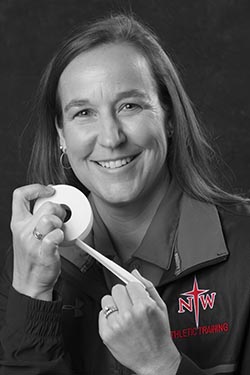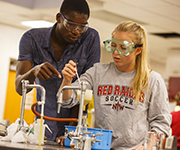Jennifer Rogers
Working Toward Wellness

DOUG BURG
In addition to serving as a kinesiology professor, Jennifer Rogers directs Northwestern’s athletic training program. A former collegiate volleyball player, she enjoys working with student-athletes as a way to keep her clinical skills sharp and to show students firsthand how to practice what she teaches.
You earned a bachelor’s degree in psychology and human resource management. Why make the switch to athletic training?
I still love psychology, and I actually use it every day. But I couldn’t see myself trying to help people solve problems that often stemmed from their surroundings, which I have no control over. I found that helping people get healthy physically suited my personality.
What fascinates you about the human body?
The body is a huge kinetic chain. Just because your knees hurt doesn’t mean the problem lies at the knees. It might be due to your inner core or the shoes you’re wearing, or because you’ve been sitting all day long and your hamstrings and glutes are weak. The body is so complex and adapts well to the forces and actions we require of it. I feel like a detective every day, trying to discover why something feels wrong and helping solve the problem.
You know firsthand what can happen when something is wrong. What has been the most challenging health problem you’ve had to deal with personally?
Our son Kaden was born with a congenital heart defect and had three open heart surgeries before he was 2 years old. There are many complications with these surgeries, as the purpose was to change the heart’s anatomy and physiology so it could function as long as possible.
And what is Kaden up to these days?
Kaden’s pediatric cardiologist refers all of her patients with that defect to the Make-A-Wish Foundation. In September he was granted a wish and got to spend two days behind the scenes with ESPN’s College GameDay. He played catch with hosts Rece Davis and David Pollack, sat on Lee Corso’s lap, and saw the mascot headgear before the big reveal. It was an experience he will never forget.
What’s the worst athletic injury you’ve ever treated?
The worst so far has been a shoulder dislocation. In one case, I was able to reduce and treat. The other one I couldn’t, so the patient had to be taken to the emergency room.
What’s a common myth about preventing or treating injuries?
That you should continue to use ice after an injury. Research has shown that after the first 12 to 24 hours, ice is useful only for pain inhibition. Elevation and compression of an injury are actually the key strategies for reducing swelling.
What’s been your favorite memory at Northwestern?
I have built so many great relationships with students, and I love to hear from them. I think of the many conversations that have been challenging. But when these same students come back as alumni and say “thank you,” I feel it’s God’s way of telling me my work here is very worthwhile.
 A $24.5 million state-of-the-art building for the health and natural sciences is North-western’s next construction project.
A $24.5 million state-of-the-art building for the health and natural sciences is North-western’s next construction project. In the Transylvanian Alps and a gym in Romania’s Jiu Valley, Felipe Silva is helping youth climb out of a bleak environment.
In the Transylvanian Alps and a gym in Romania’s Jiu Valley, Felipe Silva is helping youth climb out of a bleak environment. First published in 1891–92, Northwestern’s Classic is celebrating its 125th anniversary.
First published in 1891–92, Northwestern’s Classic is celebrating its 125th anniversary.
Classic Comments
All comments are moderated and need approval from the moderator before they are posted. Comments that include profanity, or personal attacks, or antisocial behavior such as "spamming" or other inappropriate comments or material will be removed from the site. We will take steps to block users who violate any of our terms of use. You are fully responsible for the content that you post. Comments posted do not reflect the views or values of Northwestern College.